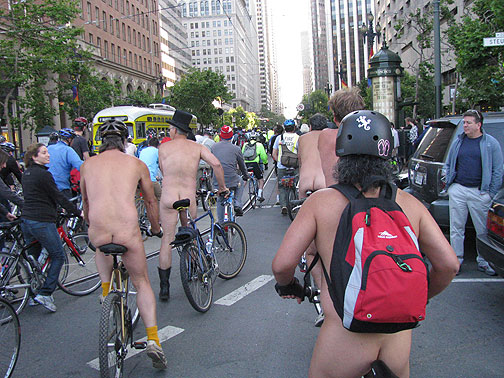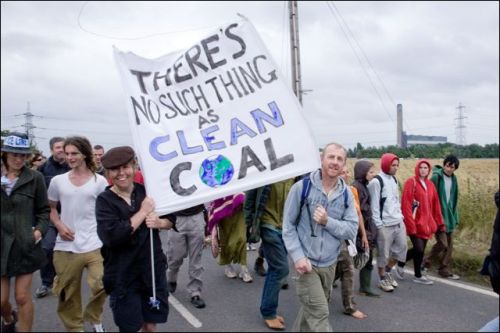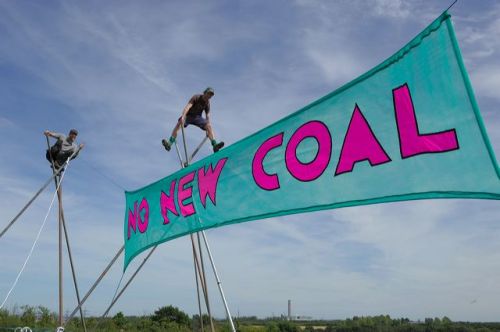posted originally at sf.streetsblog.org…
I was glad to see “We Are the World” on the ridiculously inadequate Climate Change bill that finally emerged from the corrupt U.S. Congress. Sadly, the bill could only emerge with the support of a number of mainstream environmental lobbyists in DC, who clearly have sold out to get something, anything, in the direction of addressing the climate catastrophe. Here in San Francisco there’s an inordinate amount of enthusiasm for the Bike Plan getting okayed by part of the city government, even though it’s still under an injunction, and even when that finally gets lifted, it’ll take three years to finish this Plan, one which will have relatively little effect on this car-dominated city. In some strange way the Climate Bill and the Bike Plan are eerily similar: sources of great pride to those who believe in incremental change, “the best we can do in the current political climate” to political realists, but falling way short, sorely disproportionate to the actual needs they ostensibly address. (An article in the UK Guardian Weekly June 5-11 edition “Climate Change Creates New “˜Global Battlefield'” quotes a new report from Kofi Annan’s Global Humanitarian Forum that there are already 300,000 deaths a year due to the warming climate, and 300 million people have already been affected!)

New Bike Plan! Let's Get Naked and Celebrate! Critical Mass San Francisco, June 2009.
I’m not saying anything that most people can’t readily see if we pause from our daily frenzy long enough to think about the bigger picture. I’ll go out on a limb (barely) and say here and now that the Climate Catastrophe conference scheduled for Copenhagen, Denmark in December will fail to do anything meaningful. It’s not hard to predict, since even with a 60-vote Democratic (comedian-reinforced) Majority in the U.S. Senate, there’s no chance of a treaty being ratified that addresses the structure of the U.S. economy or the geographic arrangement of our dwellings, our transit infrastructure, or our energy use. And yet, this is simply what is necessary to have ANY CHANCE AT ALL of averting catastrophic ecological and economic collapse”¦ funny to think that things are that stark, and hard to see if we don’t stop and look, but there it is.

Bike and Irreligious Pride! Sisters of Perpetual Indulgence indulging in the June 09 Critical Mass...
I get a lot of readings coming my way. Here’s a few to help you source what I’m arguing, in case you’re not sure” “this all seems rather hysterical,” “the sky isn’t really falling is it?”, and so on”¦ In the June 29 New Yorker, Elizabeth Kolbert profiles James Hansen, the NASA director who was shut up by Bush Administration decree, but wouldn’t go quietly. He’s still at NASA’s Goddard Institute for Space Studies, and in the article, Kolbert traces his emergence as one of the world’s most eloquent and urgent climate catastrophe bell-ringers.
NASA scientist James Hansen (left) gets busted protesting coal. (Photo: Rainforest Action Network)
“Hansen has now concluded, partly on the basis of his latest modeling efforts and partly on the basis of observations made by other scientists, that the threat of global warming is far greater than even he had suspected. Carbon dioxide isn’t just approaching dangerous levels; it is already there. Unless immediate action is taken” including the shutdown of all the world’s coal plants within the next two decades” the planet will be committed to change on a scale society won’t be able to cope with”¦ Speaking before a congressional special committee last year, Hansen asserted that fossil-fuel companies were knowingly spreading misinformation about global warming and that their chairmen “should be tried for high crimes against humanity and nature.”
Lately, he’s taken to marching on coal plants, and was even arrested recently. I’ve enjoyed the brilliant and funny tv spots by This Is Reality who have been doing a good job of ridiculing the rhetoric around “clean coal.” (And let’s not forget, this is the centerpiece of Obama’s energy strategy!) Not only is coal not clean, it’s about the dirtiest technology going, and if you look at what’s happening in West Virginia now, with mountaintop removal becoming the norm, it’s hard not to grow numb with despair or want to do something drastic.
The new Orion magazine has some good articles and photo essays in their July/August 09 issue on coal, but in their typical fashion, they manage to put together a treatment that goes a lot further than the basic facts. Photographs by Rick Stevens show the effects of mountaintop removal up close on the ground, but in a way that aestheticizes what should be simply ugly and monstrous. A short companion essay by West Virginia native Ann Pancake makes the point:
The photos take the ugliest landscape I’ve ever seen, the one that hurts me most profoundly, and make that landscape also beautiful. “A terrible beauty”; it was Yeats I first heard in my head. Rick has a more fitting and original phrase. He calls it “ruthless elegance.”

West Virginia is being destroyed for coal, one mountaintop at a time.
Aerial shots taken by activists are the only photos I’ve seen before this essay. Go to Mountainaction.org for the basic story with photos and videos. In West Virginia the economy has been coal-centric for two centuries, so breaking with it there is even harder than coastal latté-sippers figuring out how to reconfigure our utility bills and food-buying habits (though, as Derek Jensen argues elsewhere in the same Orion, “personal change does not equal political change,” an argument that I appreciate him making, even if he generally sends us into the cul-de-sac of blaming the “industrial economy” rather than capitalism, wage-labor, or specific technological choices and work patterns for our plight). Another piece (Hell Yes We Want Windmills) in the same issue introduces us to Coal River activists in West Virginia who are campaigning to replace the fantasy of “clean, carbon neutral coal” with wind farms.

Caravan at the gate of Kingsnorth, UK, Climate Camp 08, Kent, 9 August 2008 (photo: metamute.org)
As activism has grown around the planet, the rising call is not simply to address the Climate Catastrophe, and certainly not to blindly assert that “everyone must make sacrifices,” but rather to see that the capitalist system depends on crisis, and never fails to use it to sharpen inequalities and reinforce power relations. “Climate Justice,” like environmental justice, is the answer beginning to take shape in the global south, and in many parts of the industrialized world too. Over in Newcastle, England, near the border with Scotland, a conference was organized last November (Class, Climate Change and Clean Coal–the Climate Campers and the Unions) bringing together members of England’s storied National Union of Mineworkers with a motley crew of Climate Campers, mostly anarchist, to debate the role of coal going forward. England had a huge coal industry until the early 1980s when Margaret Thatcher decided it was the perfect target for her larger effort to break organized labor in the UK, an effort that proved fairly successful. John Cunningham (whom I had the pleasure of visiting in April) has a good account of this curious confrontation in the latest issue of MUTE magazine (A Climatic Disorder?)
Tripods with Kingsnorth power station in the background, Climate Camp, Kent, 9 August 2008 (photo: metamute.org)
Long standing anarchist activist and ex-National Union of Mineworkers (NUM) official Dave Douglass issued a polemic against the [Climate] camp. He addressed the anti-coal bias of the Climate Campers alongside a perceived lack of class analysis within the camp and the wider green movement. There is undoubtedly a feel good anti-capitalism implicit in much of the discourse around Climate Camp that can exclude any consideration of class in favour of blandly utopian sentiment”¦against the fluffy anti-capitalism of much of the camp’s official discourse, Douglass introduced the perspective of those who may not have “˜somewhere else’ to go, locked into jobs and communities that a politics of exodus cannot easily address. The yearly anti-climate change roadshow attempts to offer a response to climate change that would destabilise business as usual, suggesting at least nominally anti-capitalist alternatives. However, its model of protest camp and sustainable community gleaned from the post-Seattle summit protests can seem too abstracted from everyday life to break the general perception that climate change exists “˜out there'”¦ Its model of sustainability can also appear as a holiday in scarcity to the casual observer”¦
Climate Camp ran workshops on class and emphasised a “˜just transition’ in the official booklet’s dialogue with workers in carbon-based industries. This is the notion that a transition can be made to a non-carbon based economy that does not penalise the poor or workers in carbon based industries such as coal miners. It is an argument for responses to climate change that place social justice at the forefront of any structural shift in the economy. While it is often posited as a decentralised, autonomous response, it can also be part of a social democratic state-led one”¦
The conference often threatened to become nothing but the conjunction of two forms of reformism – trade unionism and environmentalism – disputing the response to climate change rather than providing a challenge to the commodification of the world that both climate change and capital are predicated upon… The central question the conference raised for me is how to formulate a response to climate change capable of resisting capital’s own one – given that capitalism loves a good catastrophe from which to extract value. Is there an inherent connection between capital, disaster and labour?…
The increasingly popular idea of “Transition” is filling some of the void. As noted in the Mute article, a “just transition” integrates social justice issues with the urgency of confronting the climate catastrophe. In southern California a new effort has emerged called the “Just Transition Alliance,” focusing political efforts on the fact that “climate and energy justice demand that the voices of workers and communities on the frontlines” those most affected by the policies under consideration” be heard.” (Their website at www.jtalliance.org seems to be suspended.) In the Orion issue I mentioned above, there is a central article called “The Transition Initiative,” which lays out the basic premise of this emergent movement. Climate change and/or peak oil require a democratic process of reorganizing our everyday lives. We can’t solve the problems just by making good shopping decisions, but we might be able to make important contributions by reconnecting to neighbors and friends in new communities. From such communities, scaled larger than our individual or familial lives, but not so insurmountably large as the whole planet, or even a whole nation, our actions can have greater impact, and even set in motion similar initiatives elsewhere as word is transmitted. (One great flaw of the Transition ideology as it is emerging, targeting “middle class” people for the most part, is its reliance on an addiction metaphor. I abhor the absurd argument that we’re “addicted” to oil. We live in a society that has been made structurally dependent on oil for food, transportation, heat, shelter and more, and it’s not because we were asked or we voted, but because specific wealthy interests benefited from setting things up to further their wealth and power”¦ that doesn’t make us individually addicted, it makes us modern citizens of 21st century capitalism, a pernicious social system over which we exercise almost no control!)
In San Francisco, as across California, a Transition movement has recently surfaced too. They’re having their 2nd meeting on July 21st and you can find more information and join here. On a similar tack are two efforts to start harvesting the abundant fruit trees around the city going ignored by their owners. SF Glean is one such, and another is Produce to the People, both dedicated to helping harvest fruit and deliver it for free to people who need it.

Alice Waters' Edible Schoolyard at MLK Jr. Middle School in Berkeley... one of the more coherent responses to the imperative towards Transitioning!
The Climate Catastrophe needs a lot of responses, on many levels. The Bike Plan is a teensy step in the right direction, but bicyclists and street activists really have to go a lot further. “One Lane For Food,” my favorite meme of the year, is a perfect idea for Capp Street in San Francisco! A wide garden with winding bike path (like a panhandle) down the middle, with narrow, slow one-way traffic on either side”¦ just one idea in a city bursting with possibilities. Transition Time is now! If you’re looking for some good basic ideas of what you can do right away, along with a 2-year and 3-5 year plan, check out this discussion online “Transition City: Permacultural Transformation.”














wind farms are great but they also take up a large land area,,.
actually it is not that hard to setup wind farms, the only problem is that it requires lots of capital investment.`’`